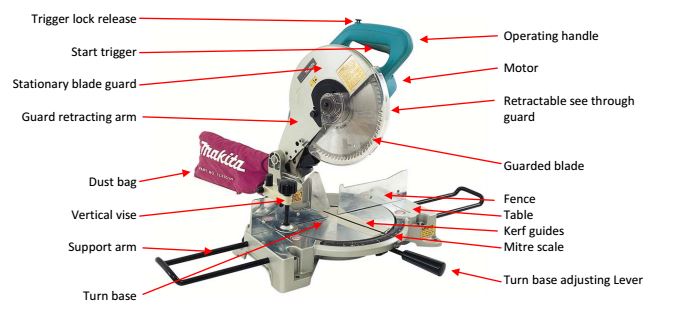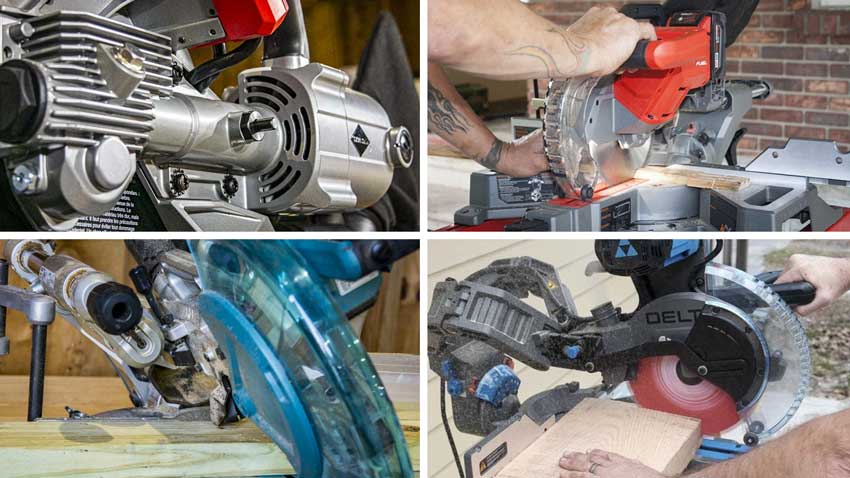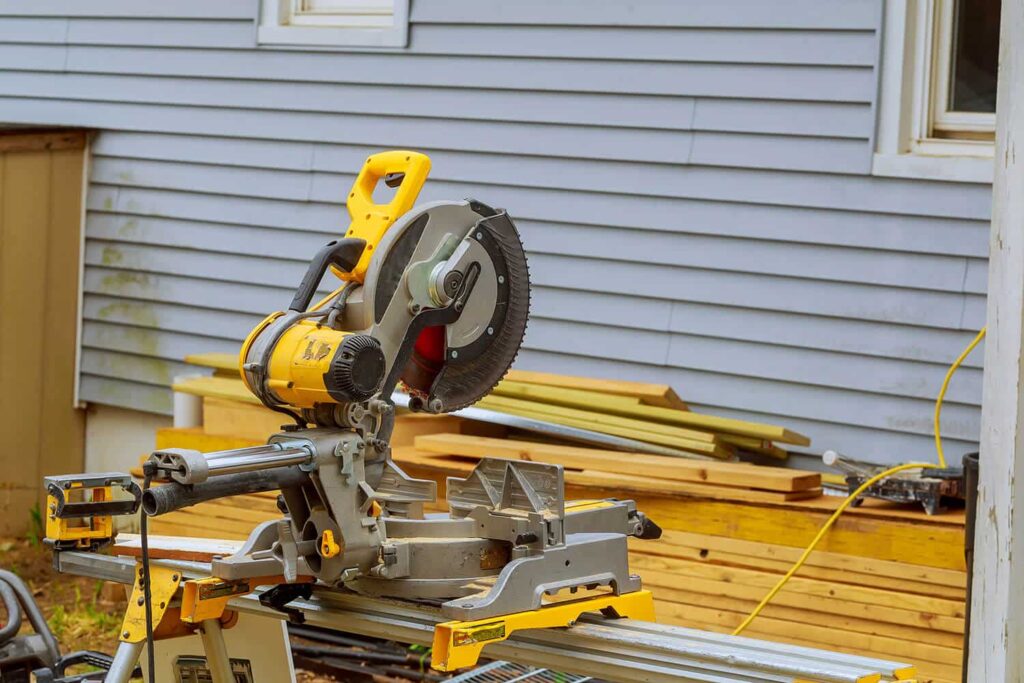Have you ever wondered, “What does compound miter saw mean?” This term sounds intimidating if you’re new to woodworking or home improvement projects.
But fear not, because in this guide, we’ll break it down into simple terms to help you understand the concept of a compound miter saw and how it can be a valuable tool in your DIY arsenal. So, let’s dive right in and demystify the meaning of a compound miter saw.
Understanding Compound Miter Saw
A compound miter saw, often referred to as a compound saw or miter saw, is a power tool used in woodworking and carpentry for making exact, calculated cuts in wood and different materials. It combines two types of rotational adjustments: miter and bevel.
Miter and Bevel Explained
Miter
A miter refers to the angle at which the saw blade tilts horizontally, allowing you to make angled cuts across the width of the material.
- A compound miter saw can be acclimated to make miter cuts at various angles, typically ranging from 0 to 45 degrees or even more to the left and right.
Bevel
A bevel refers to the angle at which the saw blade tilts vertically.
- A compound miter saw can be acclimated to make bevel cuts, typically used for creating angled cuts along the thickness or depth of the material.
- This capability makes it particularly useful for tasks like creating compound angles, such as those required for crown molding or other complex carpentry projects.
Versatility of a Compound Miter Saw
A compound miter saw is a versatile cutting tool that allows artisans and woodworkers to make precise angled cuts in horizontal (miter) and vertical (bevel) planes. This versatility makes it an essential tool for woodworking and carpentry projects, including framing, trim, and furniture construction.
Critical Components of a Compound Miter Saw
A compound miter saw comprises several key components that ensure accurate and efficient cutting.
Base
- The base is the flat, sturdy platform upon which the other components of the miter saw are mounted.
- It often includes extension wings or supports to provide stability and support for longer workpieces.
Blade
- The blade is the cutting apparatus of the miter saw, typically circular, and may have interchangeable blades for different cutting tasks.
Blade Guard
- The blade guard is a protective covering that encases the saw blade when it’s not in use and moves out of the way when you lower the blade to cut.
Miter Handle
- The miter handle is used to adjust the miter angle.
- It allows you to pivot the saw blade horizontally to make angled cuts across the width of the workpiece.
- The miter scale or gauge helps you set precise angles.

Bevel Handle
- The bevel handle controls the bevel angle adjustment.
- It tilts the saw blade vertically, enabling you to make bevel cuts.
- Like the miter handle, the bevel handle is typically accompanied by a scale for accuracy.
Fence
- The fence is a vertical barrier perpendicular to the blade on the saw’s base.
- It provides support and helps maintain the workpiece’s position during cutting, ensuring accurate and straight cuts.
Table or Work Surface
- The table or work surface is where you place the material you intend to cut.
- It usually has markings, such as rulers and scales, to assist in aligning and measuring the workpiece accurately.
Trigger or Power Switch
- The trigger or power switch is the control that starts and stops the saw’s motor.
- It’s typically located on the handle for ease of use.
Dust Collection System
- Many compound miter saws have a dust collection system, such as a dust bag or a port for connecting a vacuum.
- This system helps minimize dust and debris generated during cutting, keeping the work area cleaner and improving visibility.
Locking Mechanisms
- Various locking mechanisms secure the saw in specific positions.
- These locks prevent accidental movement and ensure precise cuts. Joint locks include the miter lock and the bevel lock.
Laser Guide (Optional)
- Some compound miter saws have laser guides that project a beam onto the workpiece, indicating where the blade will cut.
- This feature aids in achieving accurate cuts by providing a visual reference.
Types of Cuts Possible with a Compound Miter Saw
A compound miter saw is a flexible device that can make various cuts thanks to its ability to adjust both the miter angle (horizontal) and bevel angle (vertical).
Miter Cut
- This is a basic angled cut made across the width of the workpiece.
- You can adjust the miter angle to create miter cuts at various angles, typically ranging from 0 to 45 degrees or more to the left and right.
Bevel Cut
- A bevel cut is made by tilting the saw blade vertically.
- It results in an angled cut along the thickness or depth of the material.
- Bevel cuts often create chamfers, beveled edges, or compound angles in woodworking and carpentry.
Compound Miter Cut
- This combines a miter cut and a bevel cut.
- Compound miter cuts are used for complex woodworking projects where horizontal and vertical angles must be adjusted simultaneously.
- They are commonly employed in cutting crown molding, which requires miter and bevel angles to create precise compound angles.
Crosscut
- A crosscut is a straight cut made across the width of a workpiece at a 90-degree angle to its length.
- Compound miter saws can easily make crosscuts by setting the miter angle to 0 degrees and the bevel angle to 0 degrees (vertical).
Rip Cut (Limited)
- While compound miter saws are primarily designed for crosscutting and angled cuts, some models can have specialized rip-cutting blades and accessories.
- These allow for limited rip cuts, which are long, straight cuts made along the length of a workpiece.

Compound Bevel Cut (Limited)
- Some advanced compound miter saws can perform compound bevel cuts, simultaneously tilting the blade vertically and horizontally.
- This capability helps create intricate bevels and miters on complex workpieces.
Dado Cuts (optional accessories)
- With dado blade attachments or dado insert plates, a compound miter saw can make dado cuts, grooves, or channels cut into the material’s surface.
- Dado cuts are commonly used for joinery and accommodating shelves in furniture.
Notch Cuts (with appropriate setup)
- Depending on the saw’s capacity and the setup, compound miter saws can also be used to make notch cuts, which involve removing a portion of material from the edge or corner of a workpiece.
The versatility of a compound miter saw makes it an essential tool for carpenters, woodworkers, and DIY enthusiasts, as it can handle a wide range of cutting tasks with precision and accuracy. However, it’s essential to follow safety guidelines and use appropriate blades and settings for each specific type of cut to achieve the desired results safely.
Benefits of Using a Compound Miter Saw
Using a compound miter saw offers numerous benefits for woodworking, carpentry, and DIY projects.
Precise Angled Cuts
- Compound miter saws are designed for making highly accurate angled cuts.
- You can easily set the miter and bevel angles to achieve precise cuts at various angles, which is essential for tasks like creating joints, frames, and moldings.
Versatility
- These saws can handle various cutting tasks, including miter cuts, bevel cuts, compound miter cuts, and crosscuts.
- This versatility makes them suitable for various projects, from basic home repairs to intricate woodworking projects.
Efficiency
- Compound miter saws are efficient cutting tools.
- They allow you to make multiple identical cuts quickly, which is especially useful for tasks involving repetitive cutting, such as trim work or picture framing.
Cleaner Cuts
- The sharp blades and precision of compound miter saws result in cleaner and smoother cuts than other cutting tools.
- This can reduce the need for additional finishing work.
Safety Features
- Most compound miter saws have features like blade guards, electric brakes, and safety switches.
- These elements assist with limiting the gamble of mishaps and injuries while using the saw.
Ease of Use
- Compound miter saws are generally simple to work, in any event, for people with restricted woodworking experience.
- They come with precise scales and controls for adjusting angles and making accurate cuts.
Compact and Portable
- Many compound miter saws are generally conservative and lightweight, making moving to different job sites or around the workshop simple.
Time Savings
- The precision and speed of compound miter saws can save significant time on projects compared to using hand saws or other cutting tools.
- This increased efficiency can be especially valuable for professional carpenters and contractors.
Versatile Materials
- While they are commonly used for wood, compound miter saws can also cut through other materials like plastic, metal, and composites, depending on the type of blade used.
Consistency
- Compound miter saws allow for consistent and repeatable cuts, ensuring uniformity in your woodworking and carpentry projects.
Complex Cuts
- These saws are essential for making complex compound angle cuts, such as those required for crown molding, which can be challenging to achieve with other tools.
Dust Collection
- Many compound miter saws come with dust collection systems that help minimize dust and debris, improving visibility and reducing cleanup time.
How to Safely Operate a Compound Miter Saw?
Safety is paramount when operating any power tool, including a compound miter saw. Following legitimate well-being techniques can assist with forestalling mishaps and injuries.
Read the User Manual
- Before using the compound miter saw, thoroughly read the manufacturer’s user manual and become familiar with the tool’s features, controls, and safety instructions. Different models may have specific guidelines.
Wear Appropriate Safety Gear
- Always wear the following safety gear when operating a compound miter saw:
- Safety glasses or goggles to safeguard your eyes from debris.
- Hearing protection, as miter saws can be loud.
- Dust cover or respirator to safeguard against dust and debris inhalation.
- Appropriate clothing, including long sleeves and pants, to protect your skin.

Setup and Workspace
- Set up the compound miter saw on a stable, flat surface. Ensure it is securely anchored or clamped to prevent movement during operation.
- Maintain a clean and clutter-free workspace. Remove any obstacles or debris from around the saw.
Adjust the Saw
- Check that the saw blade is installed correctly and tightened.
- Adjust the miter and bevel angles as needed for your specific cutting task. Ensure the saw is aligned correctly before making any cuts.
Test Run
- Before cutting your workpiece, perform a test run without material to ensure that the saw operates smoothly and the blade is not wobbling.
Position Yourself Correctly
- Stand to the side of the blade, never directly in line with it. This reduces the risk of injury in case of a kickback.
Secure the Workpiece
- Use clamps or other suitable methods to secure your workpiece firmly to the saw’s base and fence. This prevents the workpiece from shifting during the cut.
Start the Saw
- Hold the workpiece securely and ensure it is clear of the blade path.
- Begin the saw and permit it to arrive at max throttle previously cutting.
Make the Cut
- Slowly lower the saw blade onto the workpiece and make a smooth, controlled cut. Keep both hands on the saw’s handles and maintain a firm grip.
- Do not force the saw through the material. Let the blade’s teeth do the cutting.
- Please wait for the Blade to Stop: After completing the cut, release the trigger and wait for the blade to come to a complete stop before lifting it out of the material.
Clear the Workspace
- Remove the cut-off piece and any debris from the workspace to prevent tripping hazards and maintain a clean working area.
Turn Off the Saw
- When you’re done using the compound miter saw, turn it off, unplug it (if corded), or remove the battery (if cordless) to prevent accidental starts.
Store Safely
- Store the saw in a secure location, out of reach of children and away from moisture and extreme temperatures.
Maintenance
- Regularly inspect the saw for damage, wear, and loose components.
- Keep the blade sharp and clean.
- Follow the manufacturer’s maintenance recommendations in the user manual.
Follow Safety Guidelines
- Adhere to all security rules and warnings the maker gives, and utilize the appropriate accessories and blades for your specific cutting tasks.
Common Applications of Compound Miter Saws
Compound miter saws find many applications across woodworking, carpentry, and do-it-yourself (DIY) projects.
- Renowned for their precision and efficiency, these versatile power tools make precise angled cuts horizontally (miter cuts) and vertically (bevel cuts).
- Commonly used in trim work, they facilitate the installation of baseboards, crown molding, and chair rails, ensuring seamless joints between trim pieces.
- In framing, they prove indispensable for crafting wooden frames, whether for doors, windows, or pictures, guaranteeing a professional finish.
- Cabinetmakers rely on compound miter saws to cut cabinet parts, and deck builders use them to create neatly finished deck boards and railings.
- In the world of interior design, they’re a must for crafting intricate crown molding and picture frames.
- Furthermore, these saws offer unmatched accuracy for crafting wooden furniture, constructing base shoe molding, and tackling flooring installation.
- Whether for professional architectural woodwork or home improvement DIYs, compound miter saws shine in numerous applications, enabling precise angled cuts and enhancing project quality.
Choosing the Right Compound Miter Saw
Choosing the right compound miter saw is pivotal for anyone involved in woodworking, carpentry, or DIY projects.
- The first decision is whether you need a standard compound miter saw or a sliding compound miter saw, which extends the blade’s reach for broader cuts.
- Blade size is another critical factor; it typically ranges from 7.25 inches to 12 inches, so pick a size that suits your projects.
- Power source options include corded and cordless models, each with its advantages.
- Consider your need for crosscut and vertical cutting capacity, and ensure the saw can handle the material dimensions you work with.
- Check the miter and bevel angle ranges, especially if you require precise compound cuts. Positive stops for joint angles can enhance efficiency.
- Laser guides are a helpful feature for precision.
- Remember to evaluate the dust collection system and portability, particularly if you plan to move the saw often.
- Build quality and safety features should be noticed.
- Establish a budget and read reviews for user feedback.
- Lastly, consider the warranty for added peace of mind.
By weighing these factors carefully, you can select the ideal compound miter saw that aligns with your specific needs and preferences, ensuring efficient and accurate cutting in your projects.
Conclusion
A compound miter saw is a versatile and essential tool in woodworking and construction. It combines the capabilities of a miter saw and an angle saw, allowing artisans to make precise and intricate cuts at various angles in multiple planes.
Whether you’re working on crown molding, baseboards, or complex joinery projects, understanding the concept of a compound miter saw is fundamental. This tool empowers individuals to achieve precision, creativity, and efficiency in their woodworking endeavors, making it a valuable asset in any workshop.

